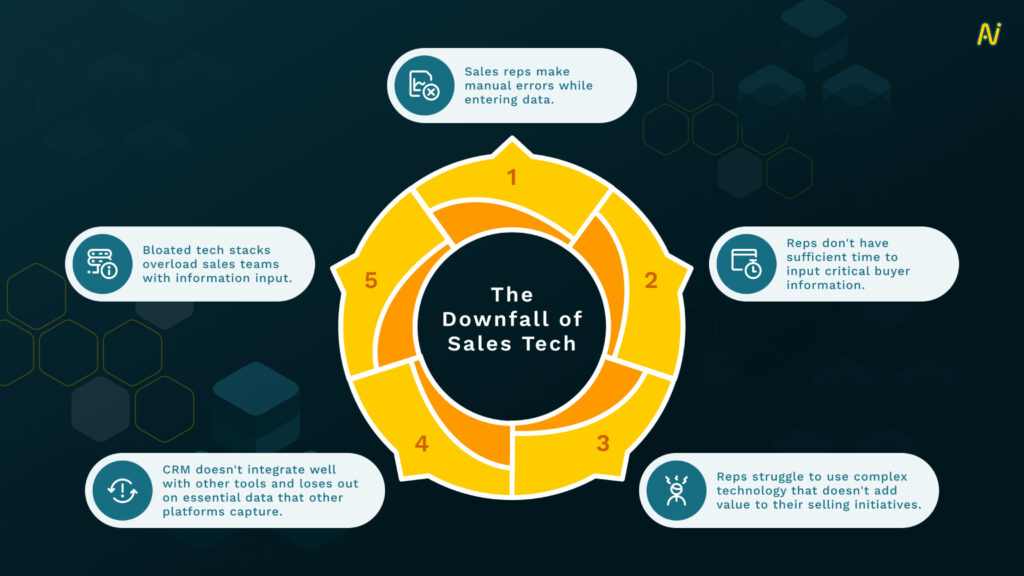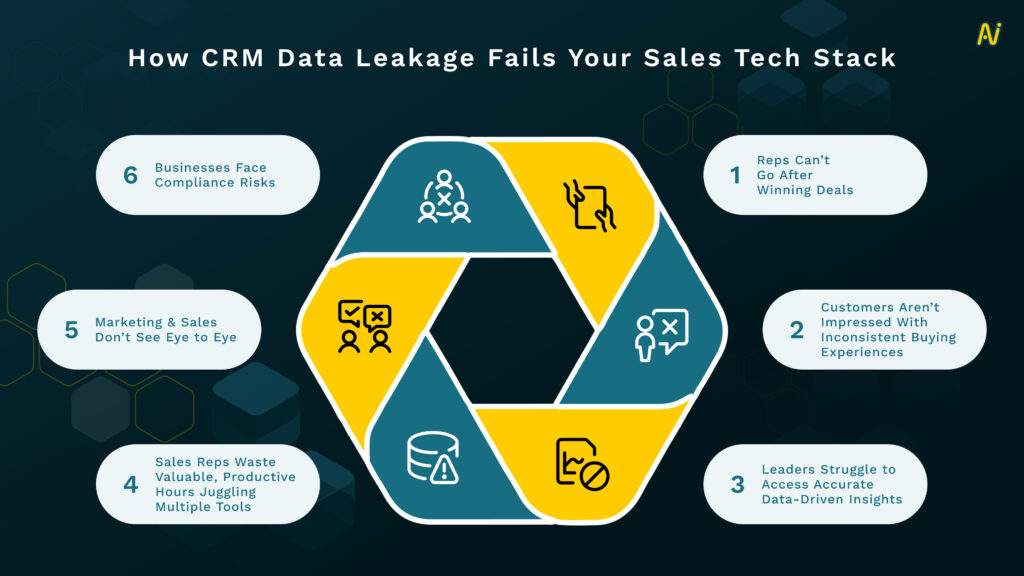The average sales tech stack stands 13 tools tall today.
You’re probably just quipping – why should it not? The benefits of sales tools are hardly a secret anymore. From streamlining and organizing to automating sales processes for better win rates and successful deal closures, organizations are reaping the rewards of deploying technology in sales.
Yet, on average, companies have blown away $313,000 on sales tools that reps don’t end up adopting. And in all probability, it’s CRM data leakage to blame.
From Where The Downfall of Sales Tech Begins
At the centre of the sales tech stack lies the CRM. Other solutions acquire data from the CRM system to shell out in-depth insights, powering business decisions across the board.
Inherently, technology is constantly innovating, and therefore, no CRM system is ever perfect. It becomes a bigger problem when the data in it is poor.
For a CRM to successfully provide accurate insights, the data that goes into it must be valuable, complete, correct, and relevant. But what if reps don’t input good-quality data? They end up in a classic cycle of “garbage in, garbage out.”

Bad data leads to low-quality insights that don’t drive revenue.
As Rosalyn Santa Elena says on The Revenue Lounge podcast,
“What’s really important is making sure you have the right data and right insights. Those are incredibly important all the time because how else do you know what’s working (for your organization) and what’s not.”
rosalyn santa elena, revops leader
While no one does this intentionally, an average sales rep juggles many roles alongside keeping their CRM running and could miss out on critical revenue data, such as—buyer contact, viable opportunities, lead status, meeting schedules, and buyer feedback due to various reasons:

Data problems can snowball over time, making corrections more complex and expensive. Ultimately, the lack of good data inside the CRM leads to many cracks in the GTM funnel, aka CRM data leakage, that bleeds out revenue.
How CRM Data Leakage Fails Your Sales Tech Stack
Here’s how CRM data leakage limits over 70% of B2B marketers from making the most out of their database.
1. Reps can’t go after winning deals
The modern sales funnel is complex. Reps need to stay involved in the post-purchase process by spotting upselling and cross-selling opportunities.
What’s stopping them from hitting the quota attainment numbers, then?
Yes, CRM data leakage. Sales reps don’t have clear visibility of the sales pipeline, and without confidence in the data, they are left to work in the dark. 30% of sales and marketing professionals face challenges in hitting revenue targets because of organizational silos, while 27% cited misunderstanding of the buyer’s journey as one of these key challenges.
Sellers must keep the sales funnel full of high-intent opportunities and stay in the know of their activities to ensure successful enterprise growth. They need to provide value in every interaction and use sales tech to understand buyer needs.
Paul Pirkle in RevOps Champions Podcast
Another 84% of employees miss business opportunities by not moving to modern data solutions. But shockingly, 79% of opportunity data collected by reps never enters the CRM. Representatives either don’t have enough time to input this data or find the processes and systems too complex to work with.
The result? Sales reps lack an in-depth understanding of the ideal customer profile (ICP). And scoring leads and segmenting prospects based on these incomplete details is significantly difficult.
That’s not all. There are multiple channels through which reps communicate with prospects.
For instance, a sales representative who talks with a prospect during a virtual call may or may not enter the details of meeting attendees into the CRM. As a result, when reps switch between numerous apps, they risk missing out on crucial information for closing a deal.
2. Customers aren’t impressed with inconsistent buying experiences
Buyers want you to understand their needs and exceed their expectations, too. And sales professionals agree. 88% know it’s critical to foresee consumer requirements in the current economic scenario.
But how many reps can make it happen?
Turns out, not many because muddled buyer insights curb deal personalization opportunities.
The potential damage that CRM data leakage causes is affecting the credibility of insights – mainly when multithreading (engaging with a buying group instead of an individual buyer) is in play.
Take, for example, a buying group reviewing the purchase of a B2B tech product. Not all stakeholders in a deal will need the same kind of information to make a purchase. While IT may need a deeper understanding of your product’s technical setup, marketing may want to understand how your product improves its ROI.
On the other hand, compelling buyer insights makes it easier for your reps to comprehend each stakeholder’s needs and provide valuable information to them, based on their requirements. Before you know it, your multithreading process will be significantly more effective for closing deals.
In the current B2B landscape, sellers who can provide comprehensive answers about their offerings, efficiently manage the growing number of buyer and seller stakeholders, and promptly direct their buyers to the best solution are more likely to close the deal. And 80% of buyers are more inclined to purchase from such consultative sellers.

Moreover, buyers demand proactive seller engagement in which the seller contacts them to arrange a meeting rather than waiting for attention during the “discovery” phase. If sellers don’t have adequate customer data, they lack knowledge of buyer journeys and are unlikely to meet customer needs.
CRM data leakage also results in wrongly targeted outreach. 49% of B2B sales professionals say this damages brand reputation. When your reps don’t have access to complete and accurate data, their campaigns may not reach intended recipients, who end up being more annoyed that you contacted them at all. After all, modern-day buyers are not impressed with spray-and-pray techniques.
How’s that for exceptional and personalized buying experiences?
Not good.
3. Leaders struggle to access accurate data-driven insights
Effectual business decisions rely on accurate forecasting and data-driven insights. The primary goal of revops leaders is to empower reps by using technology and data tools to help make more accurate decisions in fast-changing environments.
But when insights-driven sales heavily depend on data, poor data can have significant drawbacks. In fact, 85% of data leaders concur that making decisions based on dirty data costs their organization financially.
The question is, how can poor data and insights have negative repercussions on leaders?
CRM data leaks increase the effort required to gather and analyze insights for decision-making. And as such, leaders are robbed of productive ways to spend their time. Instead, they have to repeatedly vet and reevaluate information acquired from inaccurate or insufficient insights. The insights-gathering process, which should otherwise be quick and easy, takes up more than the required time with financial consequences.
CRM systems continue to be one of the most significant investments for businesses. Despite organizations spending billions of dollars on acquisitions to close data gaps, most companies fail to extract maximum value from this investment. Traditional CRMs are riddled with inefficiencies and unprepared for the demands of contemporary selling. With more time, CRMs become a significant source of revenue drain, contributing little to no value to overall business objectives.
An inefficient sales tech stack isn’t a worthy foundation for making sound data-driven decisions and persuading buyers to choose your solution over competitors.
4. Sales reps waste valuable, productive hours juggling multiple tools
Sales teams use more collaboration, coaching, onboarding, and training tools today than ever. But multiple sales tools to solve various problems can leave reps scratching their heads, figuring out which tool to use for what activity.
Inadvertently, reps may miss out on recording information or misinterpret data in the CRM system, given the tasks’ time-consuming and confusing nature.
CRM data leaks take away valuable productive hours from your sales reps, which they can spend on building customer relationships. This has a direct, adverse impact on their quota and makes selling harder for them than it already is.
Then there’s the problem of bad data that prevents your reps from working at their full potential. Generally, employees waste 50% of their time coping with mundane data quality tasks. It means sales professionals have less time for selling; therefore, they’re not as productive as they must be to capture lucrative deals.
It’s all thanks to ineffective sales tech stacks of which reps aren’t fans. An overwhelming 76% of companies say that poor adoption of sales tools is a top reason teams miss their sales quotas.

While sales tech is supposed to make selling easier, poor integration between tools in the stack builds data silos. These silos hinder team communication, make sales more challenging, and result in low sales tech adoption.
As reps find themselves confused, they find comfort in conventional tools like spreadsheets. The problem – spreadsheets are a bit archaic today and may not be synced with the CRM. Take a guess where that leaves your reps — trapped in data silos along with low productivity and impending data leakage.
In short,
Multiple tools = Multiple problems = Reduced sales productivity
The above problem bolsters the CRM data leakage flywheel. Reps lose critical contact data > they can’t extract quality insights > poor quality insights lead to poor decision-making > culminating in inferior customer experiences and loss of revenue > eventually bringing down seller morale and productivity.
5. Marketing & sales don’t see eye to eye
Why does it matter for sales and marketing to operate on the same page?
Because both departments work closely together to direct prospects from the top to the bottom of the sales funnel.
But this is somewhat far from reality, where sales and marketing misalignment has been around for a while. Even today, 9 in 10 sales and marketing professionals agree they are misaligned. And if the marketing and sales tech stacks aren’t integrated, they don’t provide unified visibility into the sales pipeline for either team.
CRM data leakage piggybacks on unintegrated tech stacks.
To make the most of buyer engagement, sales and marketing teams must participate in continuous, automated data exchange. So that when new prospect information comes in, it’s accumulated and managed with details up-to-date and ready at their fingertips.
If the above process falls through due to misalignment, you risk clumsy and ineffective lead nurturing. As a leader, you can analyze and measure a lead’s touchpoint to which a deal closure should be attributed. But without sufficient data, you can’t figure out where to invest more effort and resources. It wastes precious time and resources chasing unqualified leads, resulting in failure to capitalize on rewarding sales opportunities.
54% of prospecting teams also cannot access actionable intelligence in real time.
This misalignment between sales, marketing, and customer success teams causes them to develop blind spots. Data silos only add to the problem, creating an unclear picture of the lead pipeline and pushing leaders to make poor decisions.
Consequently, CRM data leakage leads to insufficient or below-par lead scoring. With no visibility on relevant parameters for each team, marketing and sales end up following different criteria for scoring. The misalignment of MQLs and SQLs can disrupt a company’s entire sales pipeline, undermining the excellent continuity between marketing and sales.
If you think this is an internal problem, it isn’t. 78% of customers expect consistent interactions across departments, but 59% say it usually feels like they’re communicating with separate departments, not one organization. Misalignment clearly reflects on frontline interactions with buyers.
Since marketing and sales essentially target the same customer, the handoff from marketing to sales must be frictionless and imperceptible. This allows sales reps to spend less time gathering information about the prospect (they already have it, courtesy of marketing) and focus on converting leads to customers instead.
6. Businesses face compliance risks
Nearly all organizations are adopting robust data security laws such as GDPR, CCPA, or other local data security laws. As they are legally binding, your business risks suffering steep financial fines and increased operating costs if data obtained from customers is incomplete, inaccurate, or non-compliant.
For instance, a user may have previously submitted data without agreeing to your data sharing and privacy policy. This insecure data has detrimental effects on your financial standing and reputation. To make this data compliant and secure, you need to ask users for permission to use all of their data or use only the information you’re permitted to access by law.
Digital consent, opt-ins, and privacy notifications are the new gold standard of data security. But if your CRM systems face issues with data leakage, staying compliant with these laws becomes practically impossible.
CRM data leakage presents organizations with a catch-22 scenario: You either transform your insufficient data into good data and protect your brand reputation from public criticism or let it become a significant source of revenue leakage.

Address CRM Data Leakage For A Winning Sales Tech Stack
CRM data leakage is a real problem, a culmination of every way that missing or incorrect contact data can harm a healthy sales pipeline.
Nektar presents a winning platform to solve this.
The platform automates the data enrichment process so that no user needs to perform any manual entry, and reps can focus on what they do best: selling. Other benefits include enhanced visibility into the sales pipeline, a considerable increase in buyer contacts (to support multithreading), and updated contact data with selling-related insights.
Nektar uses AI to identify and address CRM data leakages at the ground level, resulting in:
You can’t keep your eye on each prospect interaction, meeting, email, and call managed outside the scope of your CRM. That’s where Nektar comes into play. It offers better insights into the health of your pipeline by providing unified data, merging information from disparate sources and broken systems into a single, overarching view.
When your CRM data is clean, complete, and guided with AI-led revenue intelligence, all your customer-facing teams have better visibility across the sales pipeline, and you have better insights into the health of your pipeline. You receive accurate insights pinpointing which deals your reps need to focus on for better deal closure.
Businesses could also successfully implement ABM strategies at scale by using richer data in their CRM to address every customer base segment and adopt a practical omnichannel approach.
By generating more leads, guiding selling activities, preventing customer churn, and optimizing insights, you can plug CRM data leakages for your organization with Nektar. Leverage our platform to solve revenue leakage.
PUBLISHED BY








